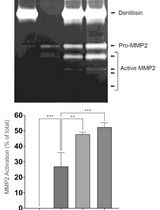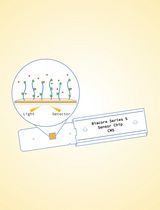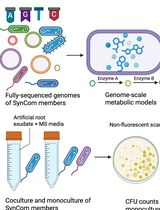- EN - English
- CN - 中文
Observation of Pneumococcal Phase Variation in Colony Morphology
肺炎球菌菌落形态学相位变异的观察
发布: 2017年08月05日第7卷第15期 DOI: 10.21769/BioProtoc.2434 浏览次数: 9712
评审: Swetha ReddyAnonymous reviewer(s)

相关实验方案

通过制备连续聚丙烯酰胺凝胶电泳和凝胶酶谱分析法纯化来自梭状龋齿螺旋体的天然Dentilisin复合物及其功能分析
Pachiyappan Kamarajan [...] Yvonne L. Kapila
2024年04月05日 1332 阅读
Abstract
Streptococcus pneumoniae (pneumococcus) is an important human pathogen that causes pneumonia, meningitis, sepsis, and otitis media. This bacterium normally resides in the nasopharynx as a commensal, but sometimes disseminates to sterile sites of humans and causes local or systemic inflammation. This biphasic behavior of S. pneumoniae is correlated with a reversible switch between the opaque and transparent colony forms on agar plates, a phenomenon referred to as phase variation. The opaque variants appear to be more virulent in animal models of bacteremia but are deficient in nasopharyngeal colonization animal models. In contrast, the transparent variants display higher levels of nasopharyngeal colonization but relatively lower virulence in animal models. We have recently demonstrated that pneumococcal phase variation between these two colony types is caused by a reversible switch of genome DNA methylation (or epigenetic) patterns, which is driven by DNA inversions in the DNA methyltransferase genes. Observation of colony morphology is a simple and useful method to differentiate colonies with different characteristics, such as size, color, and opacity. This protocol describes how to study pneumococcal phase variation in colony morphology with a dissection microscope.
Keywords: Streptococcus pneumoniae (肺炎链球菌)Background
Streptococcus pneumoniae is a leading cause of bacterial pneumonia, meningitis, and sepsis in children worldwide (Walker et al., 2013). The success of this pathogen in its adaptation to various ecological niches of human host depends on its remarkable phenotypic plasticity (Croucher et al., 2013; Johnston et al., 2014a), which has been reflected by the inter-strain antigenic variation in the capsular polysaccharides and surface proteins (Croucher et al., 2013 and 2011), acquisition of new virulence factors (Park et al., 2012), extensive drug resistance (Croucher et al., 2014) within the species. Natural genetic transformation is a well-known mechanism contributing to this phenotypic plasticity (Johnston et al., 2014b). Moreover, S. pneumoniae is also capable of spontaneous phase variation between opaque and transparent colony phenotypes, a widespread phenomenon in microbial pathogens (van der Woude, 2011). The opaque variants, which have more capsule and less teichoic acid, are more virulent in the lung and bloodstream; the transparent counterparts, which express less capsule and have more teichoic acid, are more adaptive to the nasopharynx (Kim and Weiser, 1998; Weiser et al., 1994; Manso et al., 2014; Li et al., 2016). Our recent studies have revealed that pneumococcal phase variation between two colony phenotypes is determined by DNA inversion between the methyltransferase hsdS genes in the colony opacity determinant (cod) locus (Feng et al., 2014; Li et al., 2016).
The protocol we present here describes the complete experimental procedure from preparing a bacterial stock to obtaining an image of colony morphology as described in our recent study (Li et al., 2016). Animal blood is commonly added to agar medium to promote growth of S. pneumoniae, but the color of the blood makes it difficult to differentiate opaque and transparent colonies by microscopic approach. Instead, catalase is supplemented to agar plates to culture S. pneumoniae by neutralizing the inhibition effect of hydrogen peroxide (produced by the pneumococci themselves) on pneumococcal growth when it comes to observe and document colony morphologies by dissection microscope (Kim and Weiser, 1998; Weiser et al., 1994; Manso et al., 2014; Li et al., 2016). Since colony morphology phenotypes can be indicative of bacterial physiological and pathogenic properties, this protocol may offer a valuable method to study the impact of genetic and epigenetic elements or environmental conditions on bacterial biology and disease pathogenesis.
Materials and Reagents
- Pipette tips
- Petri dishes (100 mm) (Thermo Fisher Scientific, Thermo Scientific TM, catalog number: 263991 )
- 50 ml tubes (Thermo Fisher Scientific, Thermo Scientific TM, catalog number: 339652 )
- 0.2 μm filter (Pall, catalog number: 4612 )
- 1.5 ml tubes (Eppendorf, catalog number: 022363204 )
- Spreading rods (Sigma-Aldrich, catalog number: Z376779 )
- S. pneumoniae strain ST556 (Li et al., 2012)
- Todd Hewitt broth (Sigma-Aldrich, catalog number: T1438 )
- Yeast extract (Sigma-Aldrich, catalog number: Y1625 )
- Glycerol (Sigma-Aldrich, catalog number: G5516 )
- Tryptic soy agar (TSA) (BD, DifcoTM, catalog number: 236950 )
- Catalase from bovine liver (Sigma-Aldrich, catalog number: C9322 )
- Phosphate buffered saline (PBS) (Mediatech, catalog number: 21-040-CV )
- Todd Hewitt broth with yeast extract (THY) medium (see Recipes)
- TSA medium (see Recipes)
- Catalase working solution (see Recipes)
Equipment
- Pipettes
- Dissection microscope (ZEISS, model: Stemi 2000-C )
- 37 °C water bath
- Spectrophotometer (Thermo Fisher Scientific, Thermo ScientificTM, model: GENESYSTM 30 )
- 37 °C 5% CO2 incubator (Thermo Fisher Scientific, Thermo ScientificTM, model: HeracellTM 150i )
- Autoclave (SANYO, model: MLS-3780 )
- Analytical balance (Mettler-Toledo International, model: NewClassic ML802 )
- Vortex mixer
- Centrifuge (Eppendorf, model: 5417 R )
- Class II biological safety cabinet (Thermo Fisher Scientific, Thermo ScientificTM, model: MSC-AdvantageTM Class II )
- Digital single lens reflex camera (Canon, model: EOS 550D )
- Small mirror with a diameter of ~5 cm
Procedure
文章信息
版权信息
© 2017 The Authors; exclusive licensee Bio-protocol LLC.
如何引用
Li, J., Wang, J., Jiao, F. and Zhang, J. (2017). Observation of Pneumococcal Phase Variation in Colony Morphology. Bio-protocol 7(15): e2434. DOI: 10.21769/BioProtoc.2434.
分类
微生物学 > 微生物-宿主相互作用 > 细菌
微生物学 > 微生物生物化学 > 糖类
生物化学 > 糖类 > 多糖
您对这篇实验方法有问题吗?
在此处发布您的问题,我们将邀请本文作者来回答。同时,我们会将您的问题发布到Bio-protocol Exchange,以便寻求社区成员的帮助。
提问指南
+ 问题描述
写下详细的问题描述,包括所有有助于他人回答您问题的信息(例如实验过程、条件和相关图像等)。
Share
Bluesky
X
Copy link













